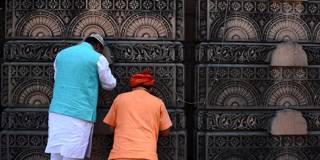At a time when India’s social fabric has been placed under unprecedented stress, Indians greeted the Supreme Court’s ruling on a long-running inter-religious dispute with almost universal relief. The Court’s verdict thus should be viewed as the start of a process of national healing.
NEW DELHI – After eight years of deliberations, India’s Supreme Court has issued a verdict that settles one of the most protracted inter-religious conflicts in the country’s turbulent history. The Court’s decision couldn’t have come at a better time.
The ruling concerns a disputed site in the dusty temple town of Ayodhya, in India’s most populous state, Uttar Pradesh. Ayodhya attracted international notoriety in 1992, when a mob of Hindu extremists tore down a Muslim mosque, the Babri Masjid, which occupied a prominent spot in a town otherwise overflowing with temples. The mosque had been built in the 1520s by a Muslim noble, Mir Baqi, in the name of India’s first Mughal emperor, Babur, on a site traditionally believed to have been the birthplace of the Hindu god-king Ram, the hero of the 3,000-year-old epic the Ramayana. The Hindu zealots who destroyed the mosque vowed to replace it with a temple to Ram and avenge a half-millennium of shame.
India is a land where history, myth, and legend often overlap; sometimes Indians cannot tell the difference. Many Hindus claim the Babri Masjid stood on the exact spot of Ram’s birth and had been placed there by Babur to remind a conquered people of their subjugation. But many historians argue that there is no proof that Babur demolished a Ram temple to build his mosque. To destroy the mosque and replace it with a temple, they maintained, would not right an old wrong, but perpetrate a new one.

NEW DELHI – After eight years of deliberations, India’s Supreme Court has issued a verdict that settles one of the most protracted inter-religious conflicts in the country’s turbulent history. The Court’s decision couldn’t have come at a better time.
The ruling concerns a disputed site in the dusty temple town of Ayodhya, in India’s most populous state, Uttar Pradesh. Ayodhya attracted international notoriety in 1992, when a mob of Hindu extremists tore down a Muslim mosque, the Babri Masjid, which occupied a prominent spot in a town otherwise overflowing with temples. The mosque had been built in the 1520s by a Muslim noble, Mir Baqi, in the name of India’s first Mughal emperor, Babur, on a site traditionally believed to have been the birthplace of the Hindu god-king Ram, the hero of the 3,000-year-old epic the Ramayana. The Hindu zealots who destroyed the mosque vowed to replace it with a temple to Ram and avenge a half-millennium of shame.
India is a land where history, myth, and legend often overlap; sometimes Indians cannot tell the difference. Many Hindus claim the Babri Masjid stood on the exact spot of Ram’s birth and had been placed there by Babur to remind a conquered people of their subjugation. But many historians argue that there is no proof that Babur demolished a Ram temple to build his mosque. To destroy the mosque and replace it with a temple, they maintained, would not right an old wrong, but perpetrate a new one.